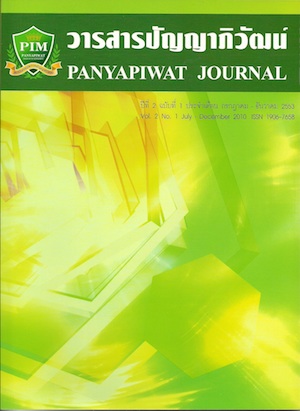An Analytical Network Process for Risk Assessment in Commercial Real Estate Development
Main Article Content
บทคัดย่อ
บทคัดย่อ
การวิเคราะห์ความเสี่ยงในธุรกิจพัฒนาอสังหาริมทรัพย์ นับเป็นการตัดสินใจระดับกลยุทธ์ที่ ส่งผลกระทบระยะยาวต่อขีดความสามารถในการแข่งขันทางธุรกิจในเชิงต้นทุนระดับพัฒนา โครงการ งานวิจัยนี้ศึกษาประเด็นผลกระทบด้านความเสี่ยงจากปัจจัยต่างๆ ที่เกิดขึ้นต่อการ พัฒนาโครงการ โดยวิธีการวิจัยใช้การจัดเก็บข้อมูลปฐมภูมิโดยการศึกษาขั้นตอนในแต่ละ กิจกรรม การสัมภาษณเ์ ชิงลึกกับผูเ้ กี่ยวขอ้ ง และการใหผู้ท้ รงคุณวุฒิทำการจัดลำดับความสำคัญ ของประเด็นปัญหาที่เกิดขึ้นด้วยวิธีกระบวนการเครือข่ายเชิงลำดับขั้น (Analytic Network Process: ANP) เพื่อประเมินถึงผลกระทบความเสี่ยงในการดำเนินงานที่มีผลต่อการพัฒนา โครงการต่อความเสี่ยงทางด้านสิ่งแวดล้อมและด้านสภาพสังคม ผ่านตัวอย่างกรณีศึกษา จากผลการศึกษาพบว่า การพัฒนาตัวชี้วัดการจัดการความเสี่ยงด้านสิ่งแวดล้อมและด้าน สภาพสังคมในธุรกิจพัฒนาอสังหาริมทรัพย์ ควรจะดำเนินการเป็นลำดับแรกในช่วงการศึกษา ความเป็นไปได้ของโครงการ ลำดับต่อมาคือ การปรับปรุงกระบวนการบริหารจัดการความเสี่ยง ที่สอดคล้องกับกลยุทธ์ของบริษัท ผลจากการศึกษาสามารถนำมาใช้เป็นแนวทางการเตรียม ความพร้อมของบริษัทในการปรับปรุงประสิทธิภาพในการจัดการความเสี่ยงที่มีผลต่อบริษัท เพื่อการพัฒนาและลงทุนโครงการได้อย่างยั่งยืน
คำสำคัญ : การบริหารความเสี่ยง, ธุรกิจอสังหาริมทรัพย์, กระบวนการเครือข่ายเชิงลำดับขั้น
Abstract
Risk assessment in real estate development business for strategic decision-making may have long-term impacts on competitive advantage concerning cost efficiency at the project development stage. Accordingly, this research studied impacts of risk factors on project development. The research methodologies comprised of primary observation on process activities and in-depth interviews with relevant experts and related parties. Moreover, in order to evaluate and prioritize project development issues appropriately, Analytic Network Process: ANP, a well-known multi-criteria decision-making tool, was applied to a case study in order to analyze the environmental risks and social risks associated to the project development. Major results of the research illustrated that a proper development of environmental and social risk management for property development business should be initiated during the feasibility study stage. Next, the risk management process should be enhanced to be in accordance with corporate strategy. The research findings can also assist in improving risk management performance in order to achieve sustainable project development and investment in the long run.
Keywords : Risk assessment, Commercial real estate, Analytic Network Process (ANP)
Article Details
“ข้าพเจ้าและผู้เขียนร่วม (ถ้ามี) ขอรับรองว่า บทความที่เสนอมานี้ยังไม่เคยได้รับการตีพิมพ์และไม่ได้อยู่ระหว่างกระบวนการพิจารณาลงตีพิมพ์ในวารสารหรือแหล่งเผยแพร่อื่นใด ข้าพเจ้าและผู้เขียนร่วมยอมรับหลักเกณฑ์การพิจารณาต้นฉบับ ทั้งยินยอมให้กองบรรณาธิการมีสิทธิ์พิจารณาและตรวจแก้ต้นฉบับได้ตามที่เห็นสมควร พร้อมนี้ขอมอบลิขสิทธิ์บทความที่ได้รับการตีพิมพ์ให้แก่สถาบันการจัดการปัญญาภิวัฒน์หากมีการฟ้องร้องเรื่องการละเมิดลิขสิทธิ์เกี่ยวกับภาพ กราฟ ข้อความส่วนใดส่วนหนึ่งและ/หรือข้อคิดเห็นที่ปรากฏในบทความข้าพเจ้าและผู้เขียนร่วมยินยอมรับผิดชอบแต่เพียงฝ่ายเดียว”
References
Adair, A., Hutchison, N. (2005). The reporting of risk in real estate appraisal property risk scoring. Journal of Property Investment and Finance, 23(3), 254-268.
Bank of England. Financial Stability Board. (2007). Financial stability report, April 2007, Issue No. 21. Retrieved November 12, 2007, from http://www.bankofengland.co.uk/publications/fsr/index.htm
Bienert, S., Brunauer, W. (2007). The mortgage lending value: prospects for development within Europe. Journal of Property Investment & Finance, 25(6), 542-578.
Blundell, G.F., Fairchild, S., Goodchild, R.N. (2005). Managing portfolio risk in real estate. Journal of Property Research, 22(2&3), 119-136.
Booth, P., Matysiak, G., Ormerod, P. (2002). Risk measurement & management for real estate portfolios.London: Investment Property Forum.
Case, K.E., Sheller, R.J., Weiss, A.N. (1995). Mortgage default risk and real estate prices: The use of index-based futures and options in real estate. Journal of Housing Research, 7(2), 243-258.
Chen, Z. (2007). Multicriteria decision-making for the sustainable built environment. Reading, UK: University of Reading.
Chen, Z., Clements-Croome, D., Hong, J., Li, H., Xu, C. (2006). A multicriteria lifespan energy efficiency approach to intelligent building assessment. Energy and Buildings, 38(5), 393-409.
Chen, Z., Li, H., Wong, C.T.C. (2005). Environ-mental planning: an analytic network process model for environmentally conscious construction planning. Journal of Construc-tion Engineering and Management, 131(1), 92-101.
CISDM Research Department (2006). To the Heart of Risk Management: Teaching Project Teams to Combat Risk, Presented Paper in the 30th Annual Project Management Institute 1999 Seminar & Symposium, Philadelphia, U.S.A.
Clarke, J.,C. and Varma, S. (1999). Strategic risk management: The new competitive edge. International Journal of Strategic Management, 32(4), 414-424.
Danter Company. (2007). A Sample lodging analysis in the City of Grove, Ohio. Retrieved August 21, 2008, from http://www.danter.com/PRODUCT/samplodg.pdf
Dun & Bradstreet Inc. (2007). Risk Management. Retrieved December 3, 2009, from http://www.dnb.co.uk/Risk_ Management/Risk_Management.asp
Financial Services Authority. (2005). Strengthening capital standards. Retrieved July 23, 2006, from http://www.fsa.gov.uk/pubs/cp/cp05_03.pdf
Fisher, J.D., Geltner, D.M., Webb, R.B. (1994). Value indices of commercial real estate: A comparison of index construction methods. Journal of Real Estate Finance and Economics, 9(2), 137-164.
French, N., French, S. (1997). Decision theory and real estate investment. Journal of Property Valuation and Investment, 15(3), 226-232.
Gibson, V.A., Louragand, M. (2002). Risk management and the corporate real estate portfolio, working paper, Centre for Real Estate Research, Business School, University of Reading, UK. Retrieved October 15, 2002, from http://www.reading.ac.uk/LM/LM/fulltxt/0202.pdf
He, Z. (1995). Risk management for overseas construction projects. International Journal of Project Management, 13(4), 231-237.
Huffman, F.E. (2002). Corporate real estate risk management and assessment. Journal of Corporate Real Estate, 5(1), 31-41.
Lee, S.L. (2002). When does direct real estate improve portfolio performance?, working paper, Centre for Real Estate Research, Business School, University of Reading, UK. Retrieved Mach 10, 2004, from http://www.reading.ac.uk/LM/LM/fulltxt/1703.pdf
Moore, W. (2006). Five ways to reduce commercial real estate risks, Working paper, Pacific Security Capital, Beaverton, USA. Retrieved September 12, 2009, from http://www.pacificsecuritycapital.com/index.cfm?action=hom.data&pageid=364
Morledge, R., Smith, A., Kashiwagi, D.T. (2006). Building Procurement. Oxford: Blackwell Publishing.
Mynors, P. (2006). What do we need to consider to deliver a more sustainable city?Presentation, CATCH Dissemination Event, Liverpool, 28-29 June 2005.
Nabarro, R., Key, T. (2005). Performance measurement and real estate lending risk. Retrieved June 12, 2006, from Real estate indicators and financial stability, BIS Papers No 21, Bank for International Settlements (BIS) Website: http://www.bis.org/publ/bppdf/bispap21.htm
Nakagawa, T., Sekitani, K. (2004). A Use of analytic network process for supply chain management. Asia Pacific Management Review, 9(5), 783-800.
Rafele, C., Hillson. D., Grimalai, S. (2005). Understanding project risk exposure using the two-dimensional risk breakdown matrix. Retrieved December 14, 2006, from Proceeding papers of 2005 Project Manage-ment Institution Global Congress, Edinburgh, Scotland Website: http://www.risk-doctor.com/pdf-files/pmi-e-rbmpaper.pdf
Saaty, T.L. (1999). Fundamentals of the analytic network process. Proceeding for ISAHP Conference, Kobe, Japan, August 12-14, 1999.
Saaty, T.L. (2005). Theory and applications of the analytic network process. Pittsburgh: RWS Publications.
United Nations Environment Programme. (2007). Buildings and climate change-status, challenges and opportunities. Nairobi, Kenya: UNEP.University of Massachusetts. Centre for Interna-tional Securities and Derivatives Markets. Benefits of real estate investment: 2006 update. Retrieved April 16, 2007, from http://cisdm.som.umass.edu/research/pdffiles/benefitsofrealestate.pdf

